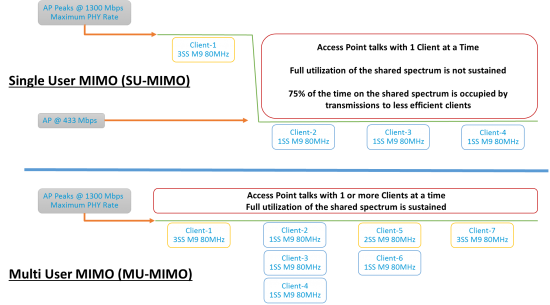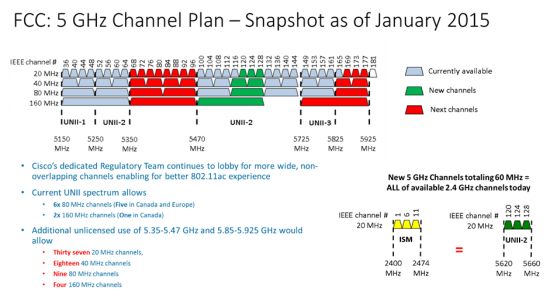































802.11ac is the hottest topic of discussion and deployment in WiFi over the past couple of years. Ratified as a standard by the IEEE in November 2013,the first phase of 802.11ac products brought to market is commonly referred to as Wave 1, and provides roughly a 3x improvement in network performance over its predecessor 802.11n: 1.3 Gbps compared to 450 Mbps in 5 GHz respectively when utilizing the maximum channel width and modulation supported .
Next up 11ac Wave 2, the next phase in 802.11ac, will begin entering the market later in 2015 in the form of both new client devices (smartphones, tablets, laptops) and new Access Points and modules, providing two significant enhancements building on Wave 1
Multi User MIMO MU-MIMO
160 MHz channel widthsupport
MU-MIMOwill enable a Wave 2 AP to talk with multiple Wave 2 clientsconcurrently, specifically in the downstream direction, AP to client. In the upstream direction, it's the same as the current Single User MIMO (SU-MIMO) where a single client at a time talks to the AP.
MU-MIMO will share all of the available wireless spectrum across multiple client devices, thereby optimizing the efficiency of the wireless network while servicing more client devices. Contrast this with today's SU-MIMO where the network services a single client at a time and based on the type of client the wireless spectrum can be fully utilized or a portion of the network left idle as a client is connected.

e.g. 1 Spatial Stream (SS) smartphone or tablet, or 2SS tablet or laptop rather than alternating up and down based on the type of individual client connected with the AP in a SU-MIMO environment.
160 MHz channel width is added to the current support of 20, 40 and 80 MHz channel widths with Wave 1, providing a boost in performance up to 2.34 Gbps from 1.3 Gbps with Wave 1. Companies have the flexibility and option to manage the amount of available wireless spectrum deployed within their network as and when appropriate.
With 802.11ac's wider channels comes a discussion of what wireless spectrum is available and it varies by geographic market. Cisco has a dedicated team championing and optimizing regulatory requirements in the Wi-Fi market place and continuously engages with all global regulatory organizations, such as the Federal Communication Commission (FCC) in the US and the European Telecommunications Standards Institute (ETSI) in the EU, to promote more spectrum commercialization. As proof the FCC recently opened up a 6thnon-overlapping 80MHz channel for 802.11ac operations (UNII-2). This discussion was discussed by Chris Spain in his blog last year entitled "What, Why, Where, When, How: The New FCC Ruling Around 5 GHz"

As Wave 2 utilizes an increased amount of available spectrum with a potential maximum data rate up to 2.34 Gbps, we legitimately start to encounter situations where Wave 2 clients and Access Points can combine to exceed a single 1G Ethernet uplink from the Access Point, and even more likely network traffic forwarded by multiple radios in the Access Point will exceed this same single 1G Ethernet uplink. This was never a real issue Wave 1.

Enter the NBASE-T Alliance co-founded by Cisco with the explicit goal of developing and bringing to market 2.5G and 5G Ethernet specifications and solutions that fill the avoid between 1G and 10G, in preparation and anticipation of 802.11ac Wave 2. NBASE-T also supports all Power over Ethernet (PoE) standards.
NBASE-T enables a single Ethernet cable approach that is cost effective while providing a range of speeds and a variety of PoE options ultimately allowing customers determine where they would like to derive cost savings from their cabling infrastructure "single cable, single switch port, longevity for existing Cat5e and new options for Cat6 and beyond, adaptive performance, and flexible powering options". Cisco announces new multigigabit switching solutions based on NBASE-T.
As we move forward in 2015, companies will see Enterprise and Carrier class Wave 2 Access Point technology and they should expect a complete Wave 2 implementation that includes both of these major enhancements to ensure they have maximum flexibility for companies as their businesses continue to shift to the "All Wireless Office" mode of operation.
That being said, 802.11ac Wave 2 clients and infrastructures will take several years to build out and reach critical mass. Thus, if you need to address Wi-Fi performance and high client density challenges seen today on your legacy 802.11n and 802.11abg networks, don't wait for Wave 2. Instead, move to Wave 1 now and in the near term and you can build out with Wave 2 in the future.
Please feel free to comment, share and connect with us onFacebook, Google+ and@Cisco_Mobility!
 Горячие метки:
Wireless and Mobility
Wi-Fi Wi-Fi
802.11ac
802.11ac wave 2
CiscoMobility
- мио
mu-mimo
mimo
Ethernet Base-T
Горячие метки:
Wireless and Mobility
Wi-Fi Wi-Fi
802.11ac
802.11ac wave 2
CiscoMobility
- мио
mu-mimo
mimo
Ethernet Base-T